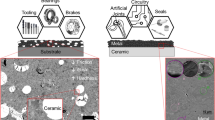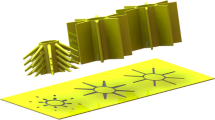Abstract
In the search for thermal management of advanced avionics packaging, materials such as eutectic liquid metal (LM) alloys and synthetic ceramics with superior thermophysical properties offer reliable and effective solutions. Conductive ceramic tubes can be used to contain LM as a coolant for heat exchangers. However, conductive ceramics will still need to be combined with metals to provide optimal thermal and structural performances. Additive manufacturing (AM) technologies have also shown they can facilitate novel approaches for fabricating efficient multi-material structures. Recently, we developed an in situ AM approach for embedding prefabricated components, such as ceramic tubes, inside a metallic block without parting surfaces for better sealing and more intimate contact between the metal and ceramic. In this selective laser sintering (SLS) approach, metal powders are melted near embedded ceramic tubes to close interfacial gaps associated with surface roughness and machining tolerances, resulting in a contact resistance at the metal–ceramic interface that is reduced relative to conventional packaging approaches. In this paper, we demonstrate how metallic cold plates can be fabricated with improved power dissipation by encapsulating highly conductive ceramic tubes with a SLS metal structure. To optimize the adhesion of the melt pool, the surface of the ceramics is electroplated to reduce surface defects and chemistry in order to improve the wettability of the ceramic. Experimental results of the cold plate prototypes fabricated by in situ AM technique revealed up to a 1.6× improvement in heat transfer compared to cold plates packaged by a conventional assembly technique, and results are validated through further numerical and analytical approaches.




















Similar content being viewed by others
Availability of data and material
Data are transparent and available for sharing.
Code availability
N/A
References
Didion J (2001) A prototype electrohydrodynamic driven thermal control system (EHD-TCS). Am Inst Phys Conf Proc 552(1). https://doi.org/10.1063/1.1357940
Ohadi MM, Choo K, Dessiatoun S, Cetegen E (2013) Next generation microchannel heat exchangers. Springer, New York
Shooshtari A, Mandel R, Ohadi M (2012) Cooling of next generation electronics for diverse applications. In: Anwar S (ed) Encyclopedia of energy engineering and technology. Taylor and Francis, New York. https://doi.org/10.1081/E-EEE-120048075
Deisenroth DC, Moradi R, Shooshtari AH, Singer F, Bar-Cohen A, Ohadi M (2018) Review of heat exchangers enabled by polymer and polymer composite additive manufacturing. Heat Transfer Engineering 39(19):1648–1664. https://doi.org/10.1080/01457632.2017.1384280
Egelkraut S et al (2008) Highly filled polymers for power passives packaging. Proc. of the Second Electronics System Integration Technology Conf., London, UK, In, pp 403–410
Zeigarnik YA (1996) Liquid metal heat transfer. In: Intl. Encyclopedia of Heat & Mass Transfer. Thermopedia, Redding, CT, pp 673–675
Hodes M, Zhang R, Lam LS, Wilcoxon R, Lower N (2013) On the potential of Galinstan-based minichannel and minigap cooling. IEEE Trans Compon Packag Manuf Technol 4(1):46–56
Tang S-Y, Khoshmanesh K, Sivan V, Petersen P, O’Mullane AP, Abbott D, Mitchell A, Kalantar-zadeh K (2014) Liquid metal enabled pump. Proc of the National Academy of Sciences 111:3304–3309. https://doi.org/10.1073/pnas.1319878111
Ma K, Liu J (2007) Liquid metal cooling in thermal management of computer chips. Frontiers of Energy and Power Engineering in China 1(4):384–402
Miner A, Ghoshal U (2004) Cooling of high-power-density microdevices using liquid metal coolants. Appl Phys Lett 85(3):506–508
Li P, Liu J (2011) Self-driven electronic cooling based on thermosyphon effect of room temperature liquid metal. J Electron Packag 133(4)
Geddis PJ, Wu L, McDonald AM, Chen SWS, Clements BR (2020) The effect of static liquid Galinstan on common metals and non-metals at temperatures up to 200° C. Can J Chem 98:787–798. https://doi.org/10.1139/cjc-2020-0227
Chu W-X, Khatiwada M, Wang C-C (2020) Investigations regarding the influence of soft metal and low melting temperature alloy on thermal contact resistance. International Communications in Heat and Mass Transfer 116:104626
Xian Y, Zhang P, Zhai S (2018) Peng Yuan, and Daoguo Yang (2018) Experimental characterization methods for thermal contact resistance: a review. Appl Therm Eng 130:1530–1548
Ji Y, Yan H, Xiao X, Xu J, Li Y, Chang C (2020) Excellent thermal performance of gallium-based liquid metal alloy as thermal interface material between aluminum substrates. Appl Therm Eng 166:114649
Doumouro, Joris, Elodie Perros, Alix Dodu, Nancy Rahbany, Dominique Leprat, Valentina Krachmalnicoff, Rémi Carminati, Wilfrid Poirier, and Yannick De Wilde (2020) Quantitative measurement of the thermal contact resistance between a glass microsphere and a plate. arXiv preprint arXiv:2012.04291.
Silvonen J, Levänen E, Uusitalo M (2020) The thermal contact resistance of a steel-ceramic interface with oxide intermediates. Cogent Eng 7(1):1720057
Saltonstall CB, McClure ZD, Abere MJ, Guzman D, Reeve ST, Strachan A, Kotula PG, Adams DP, Beechem TE (2020) Complexion dictated thermal resistance with interface density in reactive metal multilayers. Phys Rev B 101(24):245422
Pan X, Cui X, Liu S, Jiang Z, Wu Y, Chen Z (2020) Research Progress of Thermal Contact Resistance. J Low Temp Phys 201(3):213–253
Bahrami M, Yovanovich M, Culham R (2005) Thermal contact resistance at low contact pressure: effect of elastic deformation. Int J Heat Mass Transf 48(16):3284–3293
He B, Mortazavi B, Zhuang X, Rabczuk T (2016) Modeling Kapitza resistance of two-phase composite material. Compos Struct 152:939–946. https://doi.org/10.1016/j.compstruct.2016.06.025
Zhao D, Qian X, Gu X, Jajja SA, Yang R (2016) Measurement techniques for thermal conductivity and interfacial thermal conductance of bulk and thin film materials. ASME J Electron Packag 138(4) Article 040802. https://doi.org/10.1115/1.4034605
Yu W, Liu C, Lin Q, Zhang P, Ma W, Yue Y, Xie H, Larkin LAS (2018) Advanced thermal interface materials for thermal management. Eng Sci 2(9):1–3
Coronel JL Jr., Billah KMM, Wicker R, Espalin D (2018) Hybrid manufacturing with FDM technology for enabling power electronics component fabrication. Solid Freeform Fabrication, 29th Annual International Symposium—An Additive Manufacturing Conf
McVey RW, Melnychuk RM, Todd JA, Martukanitz RP (2007) Absorption of laser irradiation in a porous powder layer. J Laser Appl 19(4):214–224. https://doi.org/10.2351/1.2756854
Martukanitz RP, Melnychuk RM, Stefanski MS, Copley SM (2004) Dynamic absorption of a powder layer. In: ICALEO 2004—23rd International Congress on Applications of Laser and Electro-Optics, Congress Proceedings. https://doi.org/10.2351/1.5060217
Hodonou C, Balazinski M, Brochu M, Mascle C (2019) Material-design-process selection methodology for aircraft structural components: Application to additive vs subtractive manufacturing processes. Int J Adv Manuf Technol 103(1–4):1509–1517
Parupelli SK, Desai S (2020) Hybrid additive manufacturing (3D printing) and characterization of functionally gradient materials via in situ laser curing. Int J Adv Manuf Technol 110(1):543–556. https://doi.org/10.1007/s00170-020-05884-9
Hodge E, Ferencz RM, Solberg JM (2014) Implementation of a thermomechanical model for the simulation of selective laser melting. Comput Mech 54(1):33–51
Khairallah SA, Anderson AT, Rubenchik A, King WE (2016) Laser powder-bed fusion additive manufacturing: physics of complex melt flow and formation mechanisms of pores, spatter, and denudation zones. Acta Mater 108:36–45. https://doi.org/10.1016/j.actamat.2016.02.014
Wu Z (2019) Method for preparing ceramic package substrate with copper-plated dam. US Patent No 10:297,498
Schetz J, Allen F (1999) Fundamentals of fluid mechanics. John Wiley & Sons, New York
Yovanovich MM, Culham JR, Teertstra P (1997) Calculating interface resistance. Electronics Cooling 3(2):24–29
Acknowledgements
The authors would like to thank John Folk for powering setup and Dr. John Lenard and Thomas Anderjaska for data acquisition system configuration.
Funding
This research was supported by Northrop Grumman Corporation.
Author information
Authors and Affiliations
Corresponding author
Ethics declarations
Competing interests
The authors declare no competing interests.
Additional information
Publisher’s note
Springer Nature remains neutral with regard to jurisdictional claims in published maps and institutional affiliations.
Rights and permissions
About this article
Cite this article
Armen, J., Bruck, H.A. Improving contact resistance in metal–ceramic heat exchangers running liquid metal by additive manufacturing and ceramic tubes with electroplated films. Int J Adv Manuf Technol 113, 2101–2119 (2021). https://doi.org/10.1007/s00170-021-06813-0
Received:
Accepted:
Published:
Issue Date:
DOI: https://doi.org/10.1007/s00170-021-06813-0




